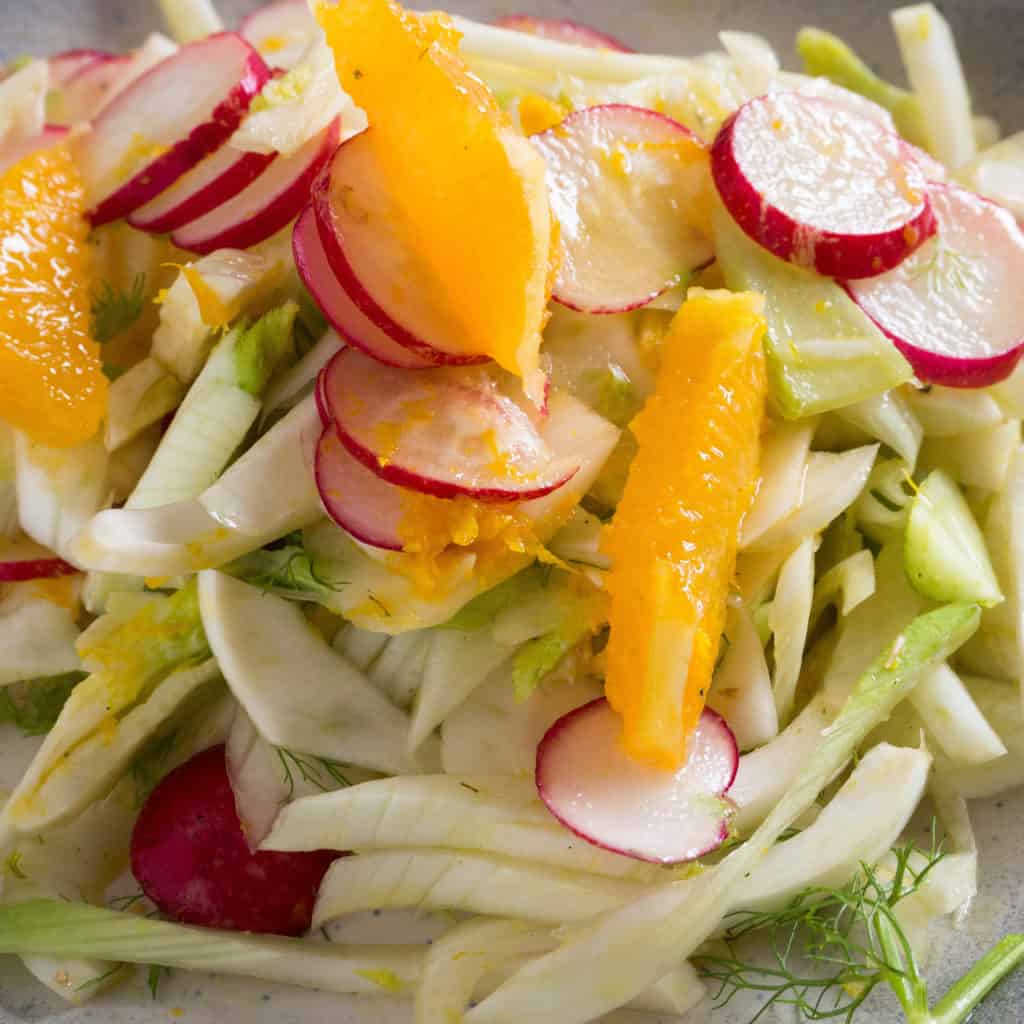
Fennel, Radish and Orange Salad makes great use of small, delicate and slightly sweet fennel bulbs and all their aniseed flavour. Fennel is an underused salad ingredient. It is light and crunchy and has an amazing aniseed flavour that works so well with mustardy radishes and citrus sweet oranges. With the juice from the oranges oozing through the salad it needs no more than olive oil and seasoning to bring this salad together.
Fennel, Radish and Orange Salad is super easy and takes less than 15 minutes to bring together.
Find the full Fennel, Radish and Orange Salad recipe here.
Fennel, Radish and Orange Salad is perfect for lunch, light dinner or as a starter for a special meal. Serve with Briam for a wonderful summer meal.
To make light work of the slicing (and to keep it uniform) use a mandolin – but watch your fingers!
Preparation
Difficulty easy
Serves 4-6
Preparation time 15 minutes
Cooking time 0 minutes
Find the full Fennel, Radish and Orange Salad recipe here.
Allergens
Fennel, Radish and Orange Salad is gluten-free and vegan as well as…
Celery free
Coconut free
Garlic free
Lupin free
Mustard free
Nightshade free
Onion free
Peanut free
Sesame free
Soya free
Tree nut free
About
Fennel is a highly aromatic and flavourful herb which tastes similar to anise and licquorice. Fennel is a much underused vegetable which is a member of the carrot family. The bulb is used as well as the feathery fronds and seeds. Fennel is a hardy, perennial herb with yellow flowers and green, feathery leaves. Although indigenous to the shores of the Mediterranean it has become widely naturalised in many parts of the world. Roman warriors are said to have consumed fennel to make them strong. It was also thought to have the power to help people keep thin. Fennel’s Greek name marathon, which means ‘grow thin’, reflects the ancient Greek belief in the ability to suppress appetite. The town of Marathon, site of the famous battle between the Athenians and the Persians, means “place of fennel”.
The Roman writer and philosopher Pliny said ‘Fennel has a wonderful property to mundify our sight and take away the film that overcasts and dims our eyes‘. The Anglo-Saxons held it sacred, and Charlemagne, the great emperor, declared in 812 AD that fennel was essential in every garden because it had healing properties.
In some western cultures, fennel was hung over doors or placed in key holes to ward off evil spirits or ghosts. It was said to be especially effective at the summer solstice.
In England in the 1200s fennel seed was commonly used as an appetite suppressant to help people to get through fasting days. Later, fennel seeds were commonly used in church during long services to keep stomachs from rumbling. The Puritans even called them ‘meeting seeds’.
In the late 1700s fennel became one of the ingredients (with anise and wormwood) in a patent medicinal elixir called absinthe. This elixir was soon marketed as a spirit, and became a popular drink among the Bohemian set in post WWI Europe and the United States.
Fennel (especially the bulb) is still popular in Europe. The bulb, foliage, and seeds of the fennel plant are used in many of the culinary traditions of the world. The small flowers of wild fennel (fennel ‘pollen’) are the most potent form of fennel, but also the most expensive.
Dried fennel seed is an aromatic, anise-flavoured spice, brown or green in colour when fresh. Fennel seeds are similar to anise, which are similar in taste and appearance, though smaller. Fennel is used as a flavouring in some natural toothpastes. Fennel seeds are used in cookery and sweet desserts. Fennel seeds are a fabulous baked in to gluten-free, vegan crackers. A 100 gram serving of fennel seeds provides 345 kilo-calories, and it is a rich source (>19% RDA) of protein, dietary fibre, B vitamins and dietary minerals, especially calcium, iron, magnesium and manganese, all of which exceed 100% DV (table). Fennel seeds are 52% carbohydrates, 15% fat, 40% dietary fiber, 16% protein and 9% water (table). But we wouldn’t eat 100 grams of fennel seeds would we?
Many cultures in India, Afghanistan, Iran, and the Middle East use fennel seed in cooking as a primary spice. It is a key ingredient of the spice mixture panch phoron. It is also a key ingredient in Chinese five-spice powder. In parts of India, roasted fennel seeds are consumed as an after-meal digestive and breath freshener, or candied as comfit. Fennel seeds are the primary flavor component in some Italian sausage. And let’s not forget fennel tea which some people adore!
The leaves are delicately flavoured and similar in shape to those of dill. They are delicious in salads, soups and stews.
The bulb is a crisp vegetable that can be sautéed, stewed, braised, grilled, or eaten raw. Fennel bulb, sliced thinly, is a key ingredient many different types of salad, often tossed with chicory and avocado. Braised fennel is a common side dish across Europe. Seasonally available fennel bulb is also often added to risotto or paella.